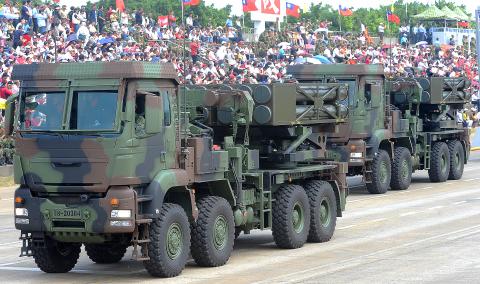Low spending on national defense as well as cuts in projected weapons acquisition, are signs that the armed forces are moving away from a combat-oriented to a relief-oriented military role and that detente in the Taiwan Strait is “unilateral,” critics of President Ma Ying-jeou’s (馬英九) administration have said.
During the presidential campaign in 2008, Ma vowed to bring spending on national defense to 3 percent of GDP, a pledge that he has not met in his four years in office. The proposed national defense budget for next year has been set at NT$314.15 billion (US$10.59 billion), lower than the NT$317.2 billion for this year.
China, meanwhile, has increased its military spending by double digits for most of the past decade, opposition lawmakers said, adding that this highlighted ignorance about the true nature of the Chinese threat on the part of the Ma administration.

Photo: Liu Hsin-de, Taipei Times
This year, China’s declared military budget will rise 11.2 percent to 670.27 billion yuan (US$106.41 billion), a figure that the Pentagon and military analysts argue does not reveal actual levels.
Beyond a failure to meet the target defense spending, appropriations for next year also indicate a shift away from combat readiness to operations other than war, predominantly relief operations, reflecting Ma’s 2009 announcement that natural catastrophes were now Taiwan’s “No. 1 enemy.”
The Chinese-language United Daily News reported on Sunday that initial plans by the army to procure 57 domestically produced Ray Ting-2000 (“Thunder 2000”) multiple rocket launchers for a total of NT$14.45 billion had been slashed by one-quarter in next year’s budget. According to the report, the Ministry of National Defense ordered in July last year that production be dropped to 43 launch vehicles, which are to be divided into three battalions. The budget for the acquisition has reportedly been cut to NT$13.22 billion.
Meanwhile, the ministry has set aside NT$860 million for eight new projects, of which more than half are to meet non-combat needs. Among the earmarked funds, NT$430 million has been set aside to purchase 73 excavators and loaders and NT$45 million to buy 128 rubber rafts.
The army said the purchases were to “strengthen disaster prevention and rescue capabilities and to expand the army’s capability to speedily repair roads and dredge waterways and reservoirs.”
Opposition lawmakers commenting on next year’s defense budget said appropriations failed to ensure the nation had the means to guarantee its defenses.
“The Ma administration has continually scaled back its military spending even though China’s threat to Taiwan has continued to rise over the past few years,” Democratic Progressive Party Legislator Hsiao Bi-khim (蕭美琴) was quoted as saying at the weekend.
Despite the relative calm in the Taiwan Strait since Ma’s election, Hsiao said the lack of reciprocity was impossible to ignore.
“The detente is just unilateral,” she said, pointing to the 1,600 ballistic and cruise missiles China has aimed at Taiwan — 200 more than last year, according to a report by the ministry on the People’s Liberation Army that was submitted to the legislature last week.
Additional reporting by AFP and Jake Chung

Beijing could eventually see a full amphibious invasion of Taiwan as the only "prudent" way to bring about unification, the US Department of Defense said in a newly released annual report to Congress. The Pentagon's "Annual Report to Congress: Military and Security Developments Involving the People's Republic of China 2025," was in many ways similar to last year’s report but reorganized the analysis of the options China has to take over Taiwan. Generally, according to the report, Chinese leaders view the People's Liberation Army's (PLA) capabilities for a Taiwan campaign as improving, but they remain uncertain about its readiness to successfully seize

Taiwan is getting a day off on Christmas for the first time in 25 years. The change comes after opposition parties passed a law earlier this year to add or restore five public holidays, including Constitution Day, which falls on today, Dec. 25. The day marks the 1947 adoption of the constitution of the Republic of China, as the government in Taipei is formally known. Back then the Chinese Nationalist Party (KMT) governed China from Nanjing. When the KMT, now an opposition party in Taiwan, passed the legislation on holidays, it said that they would help “commemorate the history of national development.” That

Taiwan has overtaken South Korea this year in per capita income for the first time in 23 years, IMF data showed. Per capita income is a nation’s GDP divided by the total population, used to compare average wealth levels across countries. Taiwan also beat Japan this year on per capita income, after surpassing it for the first time last year, US magazine Newsweek reported yesterday. Across Asia, Taiwan ranked fourth for per capita income at US$37,827 this year due to sustained economic growth, the report said. In the top three spots were Singapore, Macau and Hong Kong, it said. South

Trips for more than 100,000 international and domestic air travelers could be disrupted as China launches a military exercise around Taiwan today, Taiwan’s Civil Aviation Administration (CAA) said yesterday. The exercise could affect nearly 900 flights scheduled to enter the Taipei Flight Information Region (FIR) during the exercise window, it added. A notice issued by the Chinese Civil Aviation Administration showed there would be seven temporary zones around the Taiwan Strait which would be used for live-fire exercises, lasting from 8am to 6pm today. All aircraft are prohibited from entering during exercise, it says. Taipei FIR has 14 international air routes and